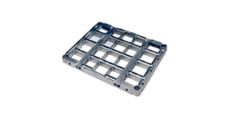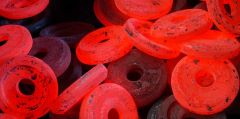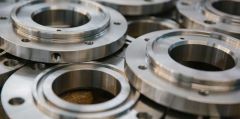Castalloy’s Product Team picks the top-five questions to ask when specifying new heat-treatment fixtures or components
Whether you are specifying permanent furnace components like a cast belt, roller tracks and fans or heat-treatment accessories like baskets, fixtures and trays, picking the right alloy and the optimal design is the best way to deliver maximum performance and lifetime at minimum cost. An alloy and design tailored to your application can help you process more parts with higher throughput for a more efficient heat-treatment process. With fewer breakages, your baskets, fixtures and trays will have a longer working life and cost you less overall. To achieve that, start with a supplier that understands heat-treatment processes. Then it’s up to you to ask the right questions – and answer any of theirs.
1. How hot is the process?
Alloy choice is based initially on the maximum and in-service process temperatures encountered. High temperatures such as 1000-2200°F (540-1200°C) require special alloys with desirable properties like low creep, excellent thermal stability and high thermal-fatigue resistance and chemical stability. There will always be compromises, however, with many alloys improving one aspect of performance but hindering another. Custom alloys with compositions fine-tuned to match your application can offer substantial advantages.
Any supplier must have the knowledge and experience to match the alloy and design to your specific application. If they get the choice wrong, problems range from creep, cracking and warpage through metal dusting and thermal fatigue to deformation.
Cast alloys generally have higher levels of carbon, which gives them greater oxidation resistance, hot strength and creep resistance. The casting process also allows total design freedom. This can be exploited to enable lightweight designs, which conserves alloy and process energy, and selective strengthening, which counteracts warpage and sagging due to an alloy’s lower yield strength at temperature and related mechanisms such as creep. Strengthening through design can also partially counteract the natural temperature gradient within the furnace zones.
2. What is the furnace atmosphere, and how many daily thermal cycles must the fixture cope with?
There are a wide variety of furnace types and atmospheres with different chemicals and workflows for each process, like annealing or carburizing. Carburizing, oxidation and nitriding processes – in addition to their desired effect on new parts – also embrittle furnace components and heat-treatment accessories over time.
Vacuum and inert-gas furnace atmospheres make oxidation resistance less important in alloy selection, although you have to consider high-temperature absorption of other residual gases too. Even if they are not part of the process, carbon and nitrogen are combustion byproducts that are commonly found in many furnaces. Therefore, picking an alloy that resists undesired heat-treatment effects like oxidation, carburization or sulfidation is vital. For example, stainless steel becomes increasingly brittle due to the formation of sigma-phase particles during repeated cycles of high-temperature heating and cooling. Higher Ni, Si and Cb levels in high-temperature alloys can avoid this, while higher Cr levels help resist sulfur. Resistance often comes from the oxide layer that certain alloys form, but this has potential downsides too. The layer can thicken and spall, leaving the alloy unprotected, while oxide formation in cracks can cause rupture failure.
Specifying your process’s range, frequency and rate of temperature cycling is vital because it can have a huge effect on design and alloy selection. High thermal-expansion rates combined with low heat conductivity in heat-resistant alloys creates internal stresses, which can cause rupture and other failure modes like thermal fatigue cracking when added to loading stress from components.
Fixtures and fittings must have good tolerance and dimensional stability while resisting surface deterioration and component deformation, putting the focus on the selected alloy’s thermo-physical properties. Creep-strength, stress-rupture and thermal-fatigue properties must all be considered. Designs often incorporate expansion loops to reduce the internal stresses that heat cycles produce.
Sample High-Temperature Alloys and their Typical Heating Applications
| Temperature | Annealing / Hardening Aire / N2 / H2 - soft cooling |
Application |
| 2192'F / 1200'C |
HX |
Severe quenching, resist thermal fatigue, trays, furnace rolls |
| 2012'F / 1100' C | HX | Resistance to oxidation and thermal fatigue, severe quenching applications |
| 1832'F / 1000'C |
HU |
Commonly used for carburizing and oil quench, trays and fixtures |
| 1652'F / 900'C | HK HL HW HX |
Excellent strength and stability to 2000'F, furnace parts, carburizing fixtures, shafts and rails |
3. What are the size, shape and weight of the parts that each fixture has to support?
Fixtures and fittings must be strong enough to support their intended load – with any creep or deformation kept within acceptable limits – and last for as long as possible in service. Specify the type, shape, weight and number of products a fixture will carry and how much fixture deformation is acceptable in your process, if any.
Components must fit comfortably and be held safely in position, with their weight distributed evenly, to avoid cracking or broken corners on grids. Engineering in extra design strength can compensate for lower-strength alloys, but employing thicker sections has implications for process efficiency.
Designs can be validated in advance using finite element analysis (FEA), which improves the performance of accessories and permanent furnace fittings alike. Problems like scaling and oxidation holes or broken fittings like roller rails, brackets and bends are often caused by insufficiently robust designs. With FEA-optimized design strength and the optimum alloy, it is possible to improve the performance of critical components like cast links where creep and stress-rupture strength are crucial factors in pin fitment and belt dimensional stability.
4. How can a new fixture increase process performance?
Alloys must have good thermal responsiveness (aka low heat capacity) for rapid heating and cooling and be resistant to thermal fatigue to counteract crack formation. As the weight of grids and baskets can be 50% or more of the charge weight, the design cannot be too heavy or it will absorb too much heat and reduce process efficiency.
Once again, maximum performance comes back to alloy selection and best practice design. Cast alloys with high C, Cr, Ni and other primary and eutectic carbide-forming elements (such as Mo, Cb and W) give higher creep resistance for a lower fixture weight or allow a higher load for same weight.
Expert designers using state-of-the-art 3D modeling software can optimize fixtures like trays, grids and baskets to hold more components and be stackable for maximum handling and furnace capacity (within maximum furnace weight limits) while also allowing enough air/gas circulation around the product surface to promote efficient heating and cooling. They can also make manual or automatic handling easier and faster and, with the correct hole sizes for forklifts or stronger lifting handles, ensure that handling doesn’t cause fixture failure.
Expert use of C-channels or pockets adds strength and lightness where required, with FEA scoring again here by helping to ensure a fixture is as robust as it needs to be while being as light as it can be. The correct design will give maximum part-loading capacity for each fixture while keeping stresses (its own weight, part weight and cyclical temperature stresses) within acceptable limits.
5. How do I get maximum value from my component?
A new fixture or fitting’s initial cost alone should not be the deciding factor in selecting your new fixture or fitting. At the very least, compare your options based on cost per month of predicted service lifetime for a given part specification. If you have the data, it is even better to use more sophisticated ways to calculate value such as a total cost of ownership (TCO) approach.
This way, you can include process costs like furnace energy consumption, part throughput, maintenance costs and frequency of fixture replacement to calculate $/g for each part you heat treat. Putting your different supplier options through this calculation gives you solid data to compare, which takes account of fixture lifetime, thermal responsiveness and overall quality – and shows which fixture really performs best in your process and offers the best value for maximum return on your investment.
Access to that in-depth expert consultancy gives you the best chance of improving your heat-treatment performance, cost-efficiency and sustainability. An optimized fixture or fitting will make your process more efficient, cutting overall energy use, while cast products can easily be recycled at end of life. When it’s time to once again consider your options, that “cashback” will be very welcome.
Contact the Castalloy team to see how we can help.




